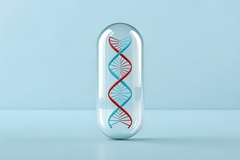Antibiotic innovation: Research group calls for 50 percent investment increase as resistance threats intensify

22 Jan 2018 --- The World Health Organization (WHO) has deemed antibiotic resistance to be one of the three greatest threats to human health today, as bacteria become increasingly resistant and too few treatments are being developed to combat them. The research project DRIVE-AB, a consortium managed by the University of Geneva (UNIGE) and AstraZeneca, has determined that a market entry reward of $1 billion per antibiotic globally could significantly increase the number of new antibiotics coming to the market in the next 30 years.
DRIVE-AB (Driving Re-investment in research and development for antibiotics and advocating their responsible use) was tasked with developing and costing new economic models to promote antibiotic innovation and the sustainable use of the resulting, novel antibiotics. The consortium, which was supported by the Innovative Medicines Initiative and brought together 23 partners including pharmaceutical companies, academic institutions, and public health organizations, assessed more than 30 incentives gathered from different industries for how each would affect antibiotic innovation, sustainable use and equitable availability.
The market entry reward, which DRIVE-AB recommends providing in addition to unit sales for qualifying antibiotics, aims to create a more attractive market for investment in antibiotic research and development (R&D) designed to attract increased and sustainable private sector funding. A market entry reward is a series of financial payments to an antibiotic developer for successfully achieving regulatory approval for an antibiotic that meets predefined criteria to address public health needs, with obligations for sustainable use, equitable availability and supply.
Based on its research, DRIVE-AB estimates that up to two innovative antibiotics addressing priority pathogens identified by the WHO could receive a market entry reward in the next five years. According to Professor Francesco Ciabuschi, a DRIVE-AB partner from Uppsala University, “Our simulations predict that introducing market entry rewards could potentially help to bring to market a total of 16-20 new truly innovative antibiotics in the next 30 years. Without incentives, some scientifically promising treatments would probably never make it to patients.”
Of the incentives the consortium analyzed, three additional models were determined to be most effective for stimulating R&D and ensuring that critical antibiotics continue to be accessible and can be used sustainably:
1) Non-refundable research grants;
2) Governmental or non-profit pipeline coordinators that identify and fill gaps in the global antibiotic pipeline; and
3) Long-term supply continuity funding to ensure a predictable supply of generic antibiotics over time.
Stephan Harbarth, professor at the University of Geneva Faculty of Medicine and co-coordinator of DRIVE-AB, highlights that “the R&D process is long. We have to implement these incentives now in order to get new antibiotics in 10 to 20 years from now.”
All of the recommended incentives would include mandatory provisions for equitable access and sustainable use in order to ensure these critical medicines are available to patients who need them globally, and remain effective over time. “The models are meant to be complementary and don’t operate in isolation. Instead, they’re designed to form an ecosystem that maximizes R&D while ensuring access and sustainable use of new antibiotics over time,” said Christine Årdal, DRIVE-AB partner and Senior Advisor at the Norwegian Institute of Public Health.
DRIVE-AB estimates that US$800 million (€680 million) is needed annually to fund grants and pipeline coordinators, an increase of about 50 percent from the current public investments in antibiotic R&D made each year. The consortium posits that the recently-announced G20 Global R&D Collaboration Hub on AMR – a facility for AMR research funders that is envisioned to guide AMR R&D to the most needed areas, foster collaboration and mobilize resources – should be considered as one possible important approach to achieving high-level coordination for incentives. The G20 should work with member states and like-minded countries to agree to implement and finance a market entry reward over a period of 20 years, including common sustainable use provisions, according to DRIVE-AB. Target product profiles, or TPPs, set by the WHO or other suitable body could serve to focus public and private investments to the areas of greatest unmet need for patients and society.
While market entry rewards are discussed and put in place, national authorities should address the economic challenges within their existing systems. The DRIVE-AB report provides suggestions for improving Health Technology Assessment (HTA) processes to better capture the societal value of antibiotics in coverage and reimbursement decision-making. DRIVE-AB also published new models to describe the spread of resistant organisms, and consensus parameters for responsible antibiotic use.
“There is no ‘one size fits all’ solution to incentivizing antibacterial innovation in a global market with varying unmet needs, healthcare systems and access requirements. A menu of incentives will ultimately be required that can be adapted to local context and yet still achieve the goal of stimulating antibacterial innovation” notes Judith Hackett, co-coordinator of DRIVE-AB and Director Global Pricing and Reimbursement at AstraZeneca.
DRIVE-AB was a public-private consortium of 23 partners from 11 countries (academic institutions, research organisations and pharmaceutical/biotechnology industries ). DRIVE-AB was one of several projects within the Innovative Medicines Initiative (IMI)’s NewDrugs4BadBugs (ND4BB) program with a budget of €9.4 million. The purpose of the project was to transform the way policymakers stimulate antibiotic innovation, while ensuring that these new antibiotics are used sustainably and are available equitably to meet public health needs. To achieve this vision, DRIVE-AB used a research-based multidisciplinary approach with significant stakeholder input and interactions.
DRIVE-AB partners included the public/academic partners British Society for Antimicrobial Chemotherapy, Chatham House, Center for Anti-Infective Agents, Heidelberg University, London School of Economics and Political Science, Norwegian Institute of Public Health, Radboud University Medical Center, Tel Aviv Sourasky Medical Center, University of Antwerp, Université de Genève, Université de Lorraine, University of Rijeka Medical Faculty, University of Strathclyde, University of Tübingen, Uppsala University, Wageningen University and EFPIA members Astellas Pharma Europe LTD, AstraZeneca AB, GlaxoSmithKline Research & Development, F. Hoffmann-La Roche Ltd, Merck Sharp & Dohme, Pfizer Limited and Sanofi-Aventis Research & Development.












